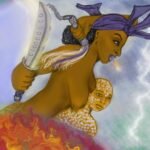Regardless of your gender, once you take on the role of masculine, to align with Shango, you need to live the life and be useful. You may not be a superathlete, but you should be taking care of yourself. Your biology is connected to your psychology, so taking the time to work out makes you healthier mentally as well as physically. If you’re disabled, you should be working on your emotional and intellectual dominance. According to the legends, he was a great sorcerer, which means he was a great scholar.
Just to be clear, we frame these things in gender because this is how human societies are currently built. In African spirituality though, we do not have a human-centric view, but accept that we have a human biased view. So awareness of our bias keeps us more accepting of all of the varieties and expressions of gender, and find a place for everybody who’s just not trying to harm people. So when discussing masculinity and leadership, we get that not everybody fits in the colonial boxes. Sometimes not even the new supposedly liberated ones. So when talking about Shango, remember we are not talking about penises here. We are talking about fire. Drive. Motivation. Active action acting on will. Movement without hesitation following the manifestation. Fire.
The Shango Altar:
If you have a home altar for all Orishas, you should have at least one natural fire and/or lightning oriented item to be or contain your part of Shango. It is difficult to explain in English. One cannot actually contain an Orisha, but the idea is that the object will embody the Orisha in a way.
If you have boxes, bottles, containers, or soperas for all of the Orishas or all of the ones who are ascended ancestors, then you should have one for Shango as well. If you do not usually use containers, then don’t start doing that with Shango, or for that matter any of the masculine or warrior type Orishas.
Your Shango items should be nearest to your Eshu items, and yet as far as is possible from the Ogun items. If you’re limited in space, put the Shango things on the opposite side of Eshu to the Ogun things. They are both part of the nature of balanced men, but they are also part of the conflict that men have between their brutal selves and their social selves. So if your Eshu things are in the corner, your Shango things should be on the opposite wall or edge from your Ogun things.
If you have any Shango necklaces or jewelry, they should be stored in a red or red and white bowl or cloth in the Shango section whenever you are not wearing them.
Shango’s symbols are the double bladed axe, lightning bolts, fire balls, and related things. There are figurines and somewhat officially designated Shango items, but one of the good things about Vodun is that we make use of what we have.
If you have the space and opportunity to make a specific Shango altar, he likes the fireplace or really anyplace where you would make a fire that is not made of iron. Make fires for Shango on stones, clay, or any kind of earth, even Pyrex or heat save glass, but not in a metal container. His weapons should be metal, but his fire should be in earth.
In my opinion, weapons placed on the altar for Shango should be real and be sharpened. Some find it acceptable to use wooden or clay replicas for him, but I do not. Perhaps this is because they just feel better to me and make me feel more connected to Shango. Follow your own way, but if the wooden version isn’t doing it for you, try getting at least a real quality knife.
Shango Devotional Incense:
This incense should be used outdoors. Put it on the fire, and step back from the smoke or you will feel like you’ve been teargassed.
- a spoonful of black pepper or coffee grounds for Eshu.
- 2 heaping spoonfuls of red pepper.
- 2 heaping spoonfuls cinnamon.
- 2 heaping spoonfuls of sandalwood powder.
- 2 heaping spoonfuls of oudh/aloeswood powder.
- a spoonful of millet, yam, corn, or amaranth flour.
- a small handful of dragon’s blood resin chunks, powdered in a mortar and pestle.
- a small handful of myrrh or copal resin, powdered.
Burn on charcoal or in a roll of paper in a stone, ceramic, or pyrex type vessel, and MOVE!
Shango Devotional Oil:
If it needs to be said, do not wear this on your skin as it is. You will need just a drop or two in a recipe for male attraction oil, but this is devotional oil for burning in an oil burner or consecrating or anointing Shango items.
- 6 coffee beans or a vanilla bean cut into 3 parts, or 3 peppercorns for Eshu.
- 1 liter almond oil, or olive oil for lamps (the pure kind, not mixed with other oils).
- 12 dried red hot peppers.
- 12 dried hot light or green peppers.
- two fingers grab of tobacco.
- the skin of a yam, sweet potato, or the hairs of an ear of corn.
- (optional) half a gram to a gram of deer musk or the oil and dried sweat from someone who has just participated in an extreme sport or combat (it’s okay if there’s a bit of skin, hair, or blood in it).
Put the ingredients in a jar, and let stand in a cool, dry place for six months.







Pingback: Orisha Online Altar − Ogun, Ogoun
Pingback: List of Known Orishas/Lwa | Orisha Online Altar
Can i just make a specific altar for shango and not have anything else.